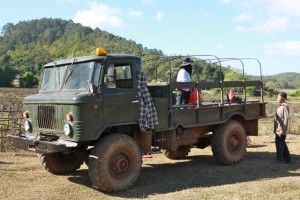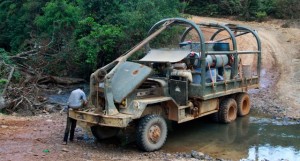Project Sekong 2012: It could be that our truck has been down the Ho Chi Minh Trail before. This workhorse makes our project possible.

Thousands of Russian trucks carried supplies down the Ho Chi Minh Trail during the war. Ever since, mechanics in Vietnam and Laos have kept trucks that survived the war in service. It takes a lot to kill a Hok Hok but when they finally go, they're cannibalized for parts.
Report 24
Early on, we sent our first truck, a Hyundai Porter, home in shame. A Porter is a low slung, flatbed truck that’s great for hauling cargo on tame roads and, when fitted with benches, it’s good transport for a team of seven or eight. But off road, where clearance is important and four-wheel drive essential, a Porter just can’t cut it. We gave ours a fair trial but at the end of our first week here, handed it a pink slip.
In it’s place we now have a Russian-built truck. (An old Russian-built truck; there are grandparents in my hometown who are younger than this truck).
Before readers dismiss my assertion that “trucks like this were just made for conditions along the old Ho Chi Minh Trail” as a cliché, they should consider this historic fact: these truck were, in fact, made for the trail, back when the old Ho Chi Minh Trail was the new Ho Chi Minh Trail.
Legend has it that small men, working in pairs, pushed bicycles loaded with military supplies down the trail, feeding the needs of soldiers fighting on behalf of the National Liberation Front (known to Americans as the “Viet Cong”) and that’s how the revolutionaries won the war.
That vision, of men in flip flops and black pajamas pushing bikes, was accurate early on, but later in the war the supply needs of NLF forces were met by a continuous flow of trucks. (The term Ho Chi Minh “Trail” fosters the misconception that the trail was a single roadway, when in fact it consisted of nearly 12,000 miles of interconnected roads, paths, and river ways).
So important were these Russian trucks to sustaining the revolutionaries in the south that the incessant American bombing campaign over the trail, intended to interdict troops and supplies, has been tagged the “war against trucks”.
In places far removed from the Vietnamese scrap metal trade you can still find trucks sitting along the trail, bombed out, burnt up, and rusted away, but still recognizable as compatriots of the Russian truck that our team is using today. The Lao call this truck the “Hok Hok”, the Lao word for “66”, supposedly the year these behemoths first appeared in the Lao countryside.
Our truck rides high over logs, stumps, and boulders and we can cross streams filled with water three feet deep. It has four-wheel drive and a creeper gear that enables it to grind its way up the steepest, most rutted tail. In the event that our truck does bog down it’s fitted with a winch and generous length of cable so we can simply hitch ourselves to a tree standing down the road and pull ourselves forward and out of trouble.
(Or, on occasion we can use the winch to create trouble for ourselves, as we did a few years ago when we managed to topple the tree that we’d hitched ourselves to, creating a roadblock. That foul-up required us to chop the tree into logs and roll them aside before we could again employ the winch, this time gripping a stronger tree.)
Mastering a Hok Hok demands climbing a steep learning curve but our current driver is a pro among pros. (Strangely, the gearshift on these trucks is to the right and behind the driver, requiring him to reach almost to the small of his back to find and operate the lever).

Every Hok Hok driver also needs to be a mechanic. Replacement parts are scarce and if a truck breaks down there is no tow truck to come to the rescue.
Our diver, who actually owns the truck and leases it to us on the condition that we hire him as driver, is also a master mechanic. I’m told that there are factories in Russia still manufacturing replacement parts for these old trucks but new parts aren’t what keep a Hok Hok on the road here. In Laos, people cannibalize old trucks for parts. Failing that, Lao mechanics will rebuild parts that Americans would give up for dead.
A few nights ago our driver took the starter out of his truck and completely disassembled it to locate a problem. Late in the evening I saw him kneeling among various parts running a file over a piece he suspected of insubordination. By morning the starter was reassembled, installed, and functioning properly.
